#inter religious dialogue
Explore tagged Tumblr posts
Text
A few thoughts while reading "Theologizin' Bigger" by Trey Ferguson.
1 note
·
View note
Text
Interfaith dialogue calls us to listen with reverence. Explore James Braha’s “Ancient Hindu Astrology” & “How to Be an Astrologer”. These books open a window into how others yearn for the heavens in search of truth. We listen first to understand. 🌌📖
0 notes
Text
six quick and easy hacks to 🆙 the quality of your fanfiction!
as promised, here it is! i’m not here to tell you how to plot out your story, or how to write your characters’ personalities. the tips i’m sharing are more on formatting and structure, secret (not really) cheat codes to instantaneously make your already written work even better!
my qualifications? being a tumblr hag for over five years (my even more embarrassing pre k-pop writeblr included!) so i’ve unlocked quite a bit of secrets and discovered some eurekas throughout my time here HAHAHAH. anyway, let’s start!

#1 VARIETY IN PARAGRAPH LENGTHS, SENTENCE LENGTHS, AND SENTENCE STARTERS.
nothing turns me off more than seeing paragraph blocks after paragraph blocks when looking for some new fics to read, especially when you’re reading from a cramped up device such as your phone.
when i write a lengthy paragraph, i try to follow it up with a one-liner, or a mid-sized one. but it’s something i consciously keep track of— when i noticed that, “oh, this gdoc is getting a little too wordy, a little too chunky,” i make sure that my next paragraph is significantly shorter than the current one because it keeps the entire page interesting. one to two sentences of lines of paragraphs after another and another doesn’t look pretty. chunks of paragraphs after paragraphs is boring.
make your pages visually dynamic by ensuring variety.
like this, for example.
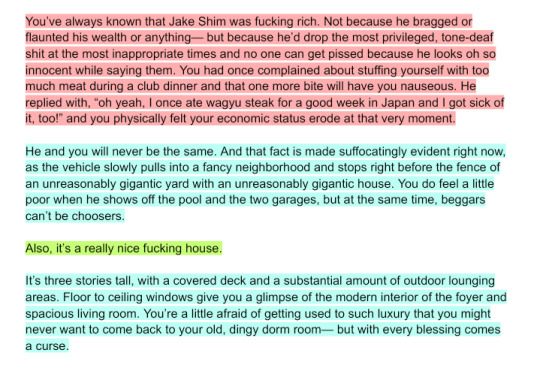
→ fic: home for the bitchless.
seeing a large chunk of text and a singular line immediately after also sort of forces your reader to stick around and read an otherwise intimidating lengthy paragraph because— oh! what could have possibly led to that singular like of dialogue or thought! #subtlemanipulation you get me? 😔🤙
this rule of mine applies to sentences and phrases within the paragraph as well!

→ fic: love vomit.
and as a bonus, you can use paragraph breaks and cuts to your advantage! manipulating the way a sentence or paragraph ends in a certain way makes your works more rhythmic! and, when you play it around the right way, abrupt cuts and breaks also add the right mood and drama to your work!
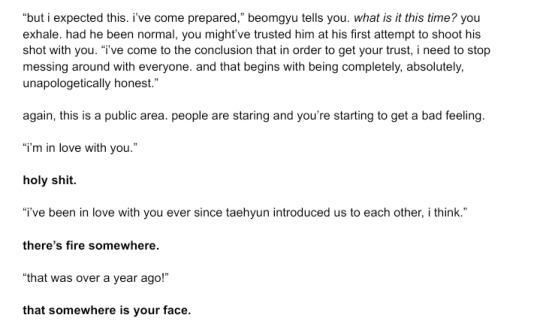
→ drabble: the boy who cried wolf.
part three of tip number one (one…we’re still at number one…) is on sentence and paragraph starters. i keep it as a rule of thumb that if i start a paragraph with “you,” or with someones name, i don’t use it again in the next one to avoid monotony. it’s a very miniscule thing really, and i doubt that people notice this HAHAHA but this is something i religiously swear by because repetitions like this are visually boring.

→ wip: sunwater.
of course, this can’t be avoided all the time, and repeating the sentence starter “You” or any other pronoun, word, or phrase can be intentionally utilized to strongly drive a point. just don’t overdo it!

→ drabble: patience, patience.

→ blurb: monsters don’t hide under the bed.

→ fic: the psychology of strawberries.
there are other good and strategic uses for repetitions as well! we’ll get to that later.
lastly, variety in sentence and paragraph starters doesn’t simply mean changing up the first word. things can still get really boring even if you use “you” or a character’s name interchangeably if your sentence structure remains the same.
this, for example, is monotonous.

the structure (and length) of all three sentences are the same. A does this. B does this. A does this. and even if you switch things up but still use the same sentence structure, it still falls flat. case in point, below, a structure i often see in a lot of fics i stumble across.

those are flat. those are boring. they don’t…you know…make you feel something, even when you follow the rule of not using the same starter twice. let me try improving it by adding more variety in the sentences (+ adding a tip that i’ll be discussing right after!)

the word “He” here is used twice to create a rhythm and draw emphasis, but the rest of the excerpt maintains a sense of variety to make the narrative more interesting and compelling to read.
*
#2 PICK A POV AND STICK WITH IT.
before i start a scene, a drabble, or blurb, the first question i ask myself is, “whose point of view do i want it to be in?”
one, it’s a lot neater, more organized, than omniscient point of views in my opinion (unless you’re like a super fucking skilled writer of course HAHAHHA). two, it allows for a bit of mystery, suspense, and engagement because you don’t have access to what other people are thinking about, and three— in line with the first tip— when you know whose brain you’re in when writing, it allows for more dynamic narrations, gives you an excuse to be messy because our internal thoughts are messy as well, and makes the writing a hell of a lot easier when you’re focused on monologuing one person alone!
when writing shorter fics, drabbles, or blurbs, i swear by this rule, no excuses HAHAHAH but when writing longer fics, sometimes i switch around the point of views per scene, just to make a more well rounded story.
sometimes, the point of view doesn’t even have to be any of the main character’s! writing from an external POV is also really fun and adds another layer of interest. see example below, a Jeonghan breakup fic written exclusively from the perspective of the outsiders. very fun idea!
breakup scene written in Seungcheol’s POV.

another squabble written in Seungkwan’s POV.

→ wip: the breakup soup.
*
#3 REPETITIONS AND THEMES = COHESIVENESS.
this section contains tricks on how to wrap up your fics into one cohesive little present with a pretty ribbon on top!
first is the use of repetition. use a cool funky line at the beginning of your story, and reuse/rehash/revise it at the end for a neat finish, especially when you have trouble figuring out a way to end your story (lifesaving hack! trust me!)
i use this mostly in my shorter works—

→ drabble: you’re my bucket list.

→ blurb: louder.
—but it works just as well with longer fics, especially when the repetition is all throughout, and not just at the start and finish.
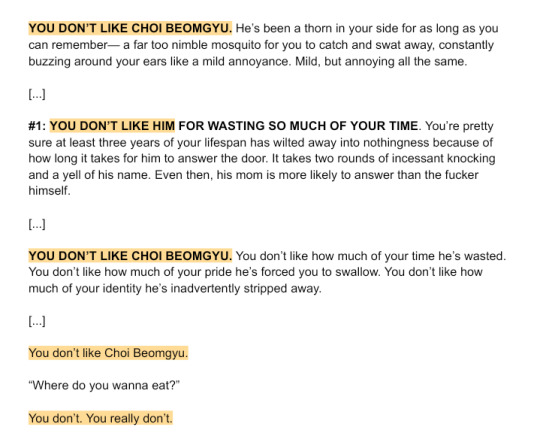
→ fic: mogi.
sometimes, it doesn’t even have to be a repeated phrase or line! it can be a little gimmick and it’d still work to make your fic cohesive! for example, in the fic below, i use the giving of strawberry candy/strawberry kisses to tie all the different scenes together because this was initially a set of separate drabble ideas wrapped into one long fic.

→ fic: the psychology of strawberries.
and for this one (another ricky fic….yes…..) i use the whole cat metaphor to do the same.

→ drabble: yours to keep.
the next tip to make your work cohesive is to grab a singular theme, object, whatever, and take advantage of it for your narration HAHAHAHHA this can be better explained by looking at the examples below.
theme: citrus.

→ drabble: citrus in the morning.
theme: storm.

→ blurb: blizzard.
the above examples are my shorter works, but it can work for longer fics as well! just check out this 36k word monster HAHAHAHHA.
theme: seasons.

→ fic: love vomit.
these are very simple ways to make your fic more put together! even if it’s just a simply blurb about a confession, adding a theme to aid the imagery bumps your fic quality to a +++++
*
#4 THROW AWAY THE Y/N’S!
now this one is quite honestly just a personal nitpick HAHAHHAHA but seeing the word Y/N when i’m reading something really pulls me out of my immersion. (and i only stopped using Y/N’s in my fics at the start of my 2023 comeback….so if you see my older works still using it…hahahha please don’t prosecute me).
anyway, you can do this either by embedding it in the narration—

→ fic: star studded baggage.
—or by using nicknames and titles instead!

→ wip: the breakup soup.

→ fic: can’t handle this.
*
#5 GET INTO THE (UN)NECESSARY SPECIFICS.
instead of just saying “Your professor called you,” grab a random last name and say “Prof Yoon asked to see you in his office.” instead of saying you went to the cafe, the mall, the store, grab an actual place or make one up because no one in the world says “they’re going to the cafe to grab a frappe,” (unless the store’s name is actually The Cafe). people say they’re going to Dunkin Donuts or Coffeebreak or wherever.
sure it’s not plot relevant, sure it’s not integral, but little things like this make your narrative and dialogue a lot more realistic and less awkward. it makes it seem like your characters are actually living inside a world of their own.
*
#6 GRAMMAR AND FORMATTING.
these are given HAHA but when i talk about grammar, i mean making sure that the commas and periods are consistently inside the quotation marks when writing dialogue. i mean minimizing the use of italics because overusing it can ruin the reading experience of a good piece (i was guilty of this too!) and i mean making sure that the use of tenses are consistent all throughout (unless if it’s a creative and plot choice), because all these things really matter if you want your fic, drabble, or blurb to be of overall high quality.

and that’s basically it! hope these tips help somehow...hope i’m not revealing my secrets for naught and someone can actually put them to good use HHAHAHHA what’s most important obviously is that you’re having fun with what you’re writing…etc. etc. insert inspirational you can do it speech here.
anyway, happy new year! and happy reading and writing<33
#writing hacks ft. my self promos HAHAHAHHAHA#tomorrow x together x reader#enhypen x reader#nct x reader#seventeeen x reader#zerobaseone x reader#riize x reader
323 notes
·
View notes
Text
Mrigashira: The Truth Is Subjective?
This is part 3 of my Mrigashira trilogy (here's part 1 & part 2)
I had previously explored the Mrigashira tendency to speak the truth and often be considered crazy for it. I thought I'd expand on this nature for this post as well.
Being truthful can mean many different things. The truth is also context-bound and what one exposes can differ based on the circumstances.

Dalai Lama- Mrigashira Mercury conjunct Rising
He has been at the forefront of the Tibetan independence movement, He has spoken up about nonviolence and his work includes a focus on the environment, economics, women's rights, non-violence, inter-faith dialogue, physics, astronomy, Buddhism and science, cognitive neuroscience, reproductive health and sexuality. He's literally one of the most admired people in the world and is considered a Bodhisattva. Being truthful or bringing attention to the truth is a big part of his life. This is not to say he isnt shady tho
He is also a very complicated figure. He used to get a personal income of over $1 million every year from the CIA for about 2 decades between 1959 and 1974?? He inappropriately touched Lady Gaga when they were on stage together, there is also a video of him asking a young boy to "suck his tongue" 🤮🤢
sometimes the truth isn't really the truth. whatever you believe to be true is what is true to you even if it does not have any basis in reality. one terrifying example of that is the Aum Shinrikyo cult leader Shoko Ashara

Shoko Asahara- Mrigashira Moon
He was the leader of the infamous cult Aum Shinrikyo, that carried out the 1995 Tokyo subway sarin gas attack and several other attacks. Asahara declared himself as God and led his followers into believing that the end of the world was coming. Its a bizarre mix of new age conspiracy theories, religious syncretism, enlightenment, doomsday mentality and pure sadism.
He and several other leaders of the cult were executed in 2018 after more than 2 decades in prison.
It goes to show how "truth" is very subjective. Shoko was a megalomaniac who was fcked in the head, yet he managed to convince manyyy people of his teachings and even got them to do whatever he wanted them to do??

Donald Trump, Mrigashira Sun conjunct Rahu, popularised the term "fake news". it is so interesting to me that a man generally known as a liar will have Mrigashira of all naks and esp have it conjunct Rahu, the planet of illusion. Astrology is funny like that sometimes. He was very forceful in spreading his truth, even though that truth was bigoted, racist, classist and misogynistic. And in one way, he helped expose people who supported him bc what is worse than being known as a Trump supporter? That is enough to gauge someone's character and nature.

Idi Amin- Mrigashira Moon
mrig nakshatra is actually present in the luminaries of many dictators/fascists/terrible leaders. Idi did not really have any specific ideology, he was a brutal narcissist who got a kick out of murdering people even at the expense of his nation's well being.
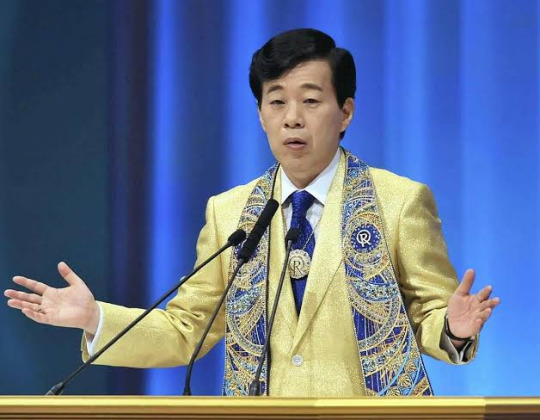
Ryuho Okawa- Mrigashira Moon & Venus
He was the leader of a cult called Happy Science and declared himself to be God. one thing that stands out to me with mrig natives is how since Mrigashira nak represents the fall from heaven, i.e, the beginning of life on earth in some ways, its natives tend to be obsessed with truth telling, I had explored more positive manifestations of this in part 1 but this tendency can be manifest in very bad ways as we see from these examples as "truth" is very subjective. Okawa was telling his truth bc he genuinely believed he was God but does that make it right?

Jennifer Lawrence, Mrigashira Moon
JLaw has always struck me honest, maybe a little too honest but that's what made her so likable initially and unlikable later on. I had mentioned this in part 1 as well about how the presence of a Mrig native often triggers other people or makes them feel threatened. part of it is the fact that Mrig has serpent yoni and subconsciously we sense the energy of other people's yoni animals and react a certain way in their presence. people with predator yoni animals strike us as intimidating. most people hate snakes and will probably kill them if they see them bc it could be dangerous and this is honestly how society reacts to a lot of serpent yoni women. So many sex symbols have serpent yoni in their big 3 (Pamela Anderson, Marilyn Monroe, Angelina Jolie, Brooke Shields etc) society seems enchanted by them but is also quick to tear them apart. people feel deeply uncomfortable with these natives is what I have noticed. JLaw's reputation suffered after she had been exposed as a try hard "cool girl". but tbh, there are celebs out there who are far more annoying and done far worse things, how come JLaw's hated for being the "cool girl"?? part of it could be that we all see our collective shadow in her, the hot sexy talented woman who seems to be a messy clumsy loser and is also "one of the boys". JLaw grew up on a farm with 2 brothers, its only natural that her personality is a little brutish and unladylike, it gets old really quick bc it seemed gimmicky but it is interesting to me how someone can be ripped apart for something so small??
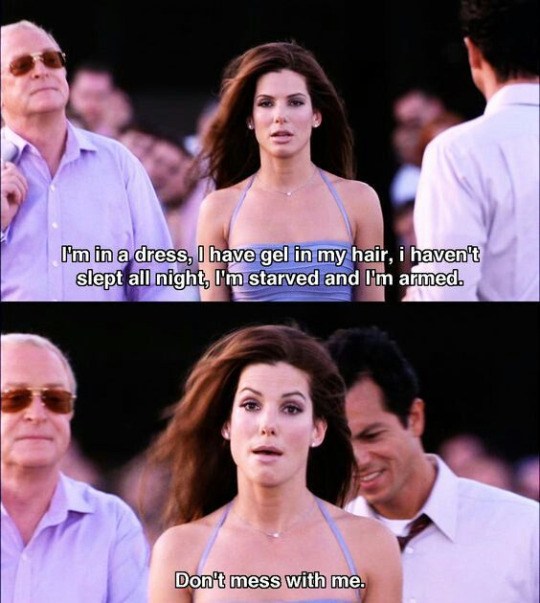
Sandra Bullock, Mrigashira Stellium
Sandra plays these unladylike but blunt and honest characters a lot (While You Were Sleeping, Two Weeks Notice, Miss Congeniality movies etc)

Sonam Kapoor- Mrigashira stellium (sun mercury & mars)
Sonam is known in the Indian media for saying whatever comes to her mouth lol, that means she makes a lot of dumb comments (she once said her being a nepo baby was the result of good karma from past lives lol and that people think you're a good actor if youre not good looking which is basically implying that she isnt considered a good actor bc she's too good looking lmfao) but she does have moments of radical no bullshit honesty, like the time she wrote an essay talking about body image
Monica from Friends always called out everyone's bullshit. She was played by Courteney Cox who is Mrigashira Sun

Leah Remini Mrigashira Sun
she exposed the dark secrets of Scientology through her memoir and docu series. this is another form of Mrigashira truth telling. exposing the darkness, evil and injustice in this world.

North West, Mrigashira Stellium (Sun & Rising)
North exposing her family is a bit of a running joke, she revealed she has dyslexia on IG live which pissed Kim off and in general she's known for her bluntness and calling out her mom esp. Kim even said that North is her "lesson" and that North "intimidates her" and how North is Kanye's twin (Kanye is also Mrigashira Sun)

Tupac Mrigashira Sun
honestly watch any interview and you can see how honest and sincere Tupac was (sidenote: isnt he sooo handsome??<33). i cant pinpoint to specific moments but Tupac was so young and sooo beyond mature?? idk if anybody in their early 20s has this kind of articulation anymore.

Paula Abdul- Mrigashira Sun
this is a bit of a strange case. Paula claims to have been in a plane crash in 1992 which left her with a spinal cord injury and forced her to take about 10 years off before she restarted her career as a judge on American Idol. she has talked about this many many times in the last 2 decades. except of course that there is zero evidence of this plane crash. obviously, she could just be lying but why lie about something that could so easily be proven? i think sometimes Mrig natives have a tendency to delusionally believe what they say. i have no doubt that Paula is convinced that she was in a plane crash and that it ruined her music career but its not objectively true.
Donald Trump & even Kanye West (both Mrig Sun) are other examples of celebrities who talk about wildly stranger things that they believe to be true.
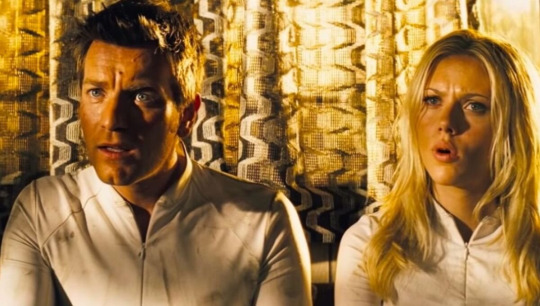
Ewan McGregor- Mrigashira moon
In the movie The Island, Ewan's character discovers that everything about his existence is a lie and that he and the other inhabitants are human clones.
I feel like this trope of realizing lies and "waking up" is tied to Mrigashira's nature.

in the movie Passengers, this happens in reverse, JLaw wakes up and then learns the truth

The Truman Show, starring Mrigashira Moon, Jim Carrey is another example of a Mrig native realising everything is a lie.
i think its a common and unfortunate pattern in the lives of many Mrig natives to suffer abuse and I feel like the reason many of them do is because they falsely believe the lies they are being fed is true :(( it takes them time to "wake up" to the truth (ex: Mrig Sun Brooke Shields who always defended her abusive mom who made her pose nude for playboy when she was a kid??? among other things, its only recently that she has started to admit that those things werent okay)
thats it for this post!!
#vedic astro notes#sidereal astrology#astrology observations#astrology notes#nakshatras#vedic astrology#astro observations#astro notes#astrology#astroblr#mrigashira#mars
115 notes
·
View notes
Note
idk how to word this but have u noticed that the attitude has suddenly shifted to people thinking instead of the fact that israel oppresses palestinians (objectively true) to all jews oppress all muslims? like my non palestinian muslim friend thanked me (american jew) for speaking up for palestine implying that their community was being oppressed by my community which is like. not true
Yeah I've noticed that! Honestly, I think that's a partially reasonable response. I get that there's a sense of tribal community that allows people of similar ethnic/religious groups to feel one another's pain-- a lot of non-Israeli Jews were devastated by the Oct. 7th pogrom, even if we didn't know anybody who was kidnapped or killed that day. I definitely won't begrudge any Arab or Muslim for deeply empathizing with the pain of the Palestinian community.
At the same time, it makes inter-community dialogue really difficult. If Arabs and Muslims act like all Jews are monolithic oppressors of all Arabs and Muslims by default, or if all Jews act like all Arabs and Muslims are monolithic Islamists by default, then I guarantee that we will never make genuine progress towards peace and reconciliation.
11 notes
·
View notes
Text
11th February 1531 - Henry VIII declared himself Supreme Head of The Church of England. This is a position that HM King Charles has inherited.
The King has never publicly expressed his own religious, or spiritual beliefs... other than expressing his concerns for the environment and our planet. But HM has always worked towards better inter-faith relationships.
Every religion believes that their way is the only way, but that is not a reason to hate people with different beliefs. We may have different beliefs... but, we can still work together to make our world a better place!
4 notes
·
View notes
Text
something i often think abt re intra-religious dialogue (and also inter-religious, as well as applicable to other issues of diversity of thought, belief, opinion etc, but I'm mainly thinking abt intra-Christian discourse where power dynamics arent as dicey) is that people are really really bad at
a) disagreeing
b) over things they think are super important
c) while still choosing to be in unity and harmony with one another.
90% of the time people have to knock one of these off. get rid of A and we're no longer disagreeing, oh good. get rid of B and it's OK we're disagreeing because none of this really matters in the end and it's all a bit silly. get rid of C and we can start burning each other at the stake for heresy.
and i get why this is the case, bc it's kind of self-perpetuating. people can't find ways to disagree over important things peacefully and so it sometimes becomes a matter of personal safety or social harmony to downplay disagreements.
for instance, i often find myself defending the idea that Abrahamics all worship the same God against evangelical Christians who argue the opposite as a way of denigrating and stereotyping Islam, and i do think we have commonalities that we should celebrate. but at the same time, this also smooths over the very real differences between us that complicate the question significantly beyond polemic. Do Jews and Muslims feel comfortable with 'same God' language when Christians worship a crucified human being as part of that God?
you get similar talking points within religions too; theologically liberal Christians who reject supernaturalism often say stuff like 'no problem with believing in Jesus' resurrection, but it shouldn't be the core of faith, it should be following Jesus'. you note the similar kind of trend - difference is acceptable and celebrated, but it needs to be downplayed. we need to minimise differences in the name of inclusion.
and i think that at its core, this approach to religious dialogue is unsatisfying and kind of just kicks the can down the road, because it doesn't address the fundamental issue of 'can we live in peace and harmony despite deeply significant differences of belief?', and instead it becomes 'we can live in peace if we're willing to downplay what we believe as not that important.'
i feel like it just gives credence to the idea that we aren't allowed to seriously disagree. like, it almost betrays this sense that we need to do everything in our power not to have serious disagreements, bc then we would have to be enemies. but i just dont think that's the case!
we need to accept our differences of belief are significant and have implications that matter for our lives - but also that it shouldn't necessarily be a barrier to friendship and dialogue or even unity. we need to actually agree to disagree, and in fact even hold our disagreement over fundamentals as a valuable thing in itself. we kind of paradoxically have to accept we dont agree on certain fundamentals so that we appreciate all the more those on which we do.
9 notes
·
View notes
Text
The Next Curve for Integral Mission in Asia

On October 14-16, 2024, the Asia Theological Association, in partnership with Tearfund in East and Southeast Asia, gathered its theological educators in Hong Kong to explore ways on how to strengthen and deepen the teaching of Integral Mission in theological seminaries and Bible colleges. The event brought forth exciting initiatives brewing on new curriculum pathways, collaborative publications, and new dimensions of mission.
On a personal note, I got a really memorable moment, one for the books, when I got to tag team with Dr Timoteo Gener in leading a session about theological thinking on Integral Mission within the contexts of East and Southeast Asia (see my other post). I tried to connect the dots as well with how the conversations went in the recently concluded 4th gathering of the Lausanne Movement in South Korea.

One of my key take aways is from a session led by Dr Dwi Maria Handayani wherein she reminded us that in Asia, Integral Mission cannot just be about responding to material poverty, it has to extend towards touching the intangibles -the restoration of the 'face' of those who have lost honor, dignity, and faith, something that the Spirit of God works through in the complexities of our interconnected lives.
The different workshops yielded a deep need to address on one hand perennial issues in the region such as:
religious, cultural, and linguistic diversity (e.g., pluralism),
colonial legacy (dualism/dualistic mindset),
socio-economic disparity (poverty and inequality),
geopolitics, restrictive policies, massive corruption in government,
and on the other hand emerging concerns brought about by:
digital technology,
an aging population and with it a widening generation gap,
climate change,
urbanization,
gender confusion,
public health,
changes in the family structures, and
churches getting even more disunited.
As a response, a wide spectrum of theological works is in order and to be carried out in ways that shall be inclusive, non-confrontational, and incarnational:
ecotheology that looks not only into creation care but also lifestyles animated by the vision of New Creation,
a more mature public theology and socio-political theologizing, and
courses on and concrete models of inter-religious dialogue.
These works have to be marked with a more applied theology, engaged pedagogy, and enriched by interdisciplinary studies. A theological endeavor that calls for the full giftings and involvement of the whole people of God, a paradigm shift from the usual theology done by 'experts' and 'specialists' toward a theologizing that stretches to the insights and experiences of the church at the grassroots level as they live their lives out there in the world as faithful disciples of Christ.
Sounds like a great deal of work ahead! But I found joy in being able to journey with friends whose hope for a more flourishing life for the people East and Southeast Asia is unwavering. It is so encouraging as well how different generations are seeing the role of each to forge a path ahead together. Talk about collaboration? Well, it does happen happily along the lines of beautiful relationship nurtured over the years.
Can't wait for the next curve of this journey!

-Rants by Rei Lemuel Crizaldo (Hong Kong, October 2024) *Read more about it in the September-October issue of Asia Theological Association (ATA)'s newsletter (pages 5-6).
2 notes
·
View notes
Text

Swedenborg: Buddha of the North (SWEDENBORG STUDIES)
"…important for anyone who is concerned with inter-religious dialogue and the meaning of… visionary mysticism." --The Reader's Review This first complete English translation of two works by Zen scholar D.T. Suzuki introduces Emanuel Swedenborg and compares Swedenborgian thought to Buddhism. The first work stresses Swedenborg's message that true spirituality demands an engagement in this world; the second compares Swedenborg's description of heaven to the paradise of Pure Land Buddhism.
2 notes
·
View notes
Text
youtube
Pope Francis has been the spiritual leader of the Catholic Church since 2013. The name he chose as Pope refers to St Francis of Assisi. He set out to reform the Vatican; he advocated climate protection and inter-religious dialogue. In March 2013, Jorge Mario Bergoglio from Argentina was elected 266th Pope, the first South American to become spiritual leader of the Catholic Church. He set out to reform the Vatican and the papal office, advocated climate protection and inter-religious dialogue. The name he chose to be known by refers to St Francis of Assisi. Following "the little poor man’s” example, Bergoglio wanted a "poor church for the poor". In memory of Pope Francis, Deutsche Welle is rebroadcasting the feature "Pope Francis — A Shepherd in the Storm.” On the occasion of the Pope's 85th birthday in December 2021, our report was an opportunity to take stock of his pontificate. What was this Pope able to change and reform; where were his limits? How did he lead the Catholic faith community through a time marked by crises and scandals? We gave people who knew Pope Francis personally, priests who advised him or were critical of his initiatives, and of course, the Catholic laity, with their hopes and belief in a just pope, the opportunity to share their image of Pope Francis.
1 note
·
View note
Text

Send from Sansgreet Android App. Sanskrit greetings app from team @livesanskrit .
It's the first Android app for sending @sanskrit greetings. Download app from https://livesanskrit.com/sansgreet
Bettina Sharada Bäumer.
Bettina Sharada Bäumer (born 12 April 1940) is an Austrian scholar of religion. Vandana Parthasarathy, writing in The Hindu, described Baumer as a "renowned Indologist, one of the foremost expounders of Kashmir Saivism and a well-known figure in the field of inter-religious dialogue". She was awarded the Austrian Decoration for Science and Art by Government of Austria in 2012 and Padma Shri by Government of India in 2015 for her contribution to Literature and Education.
#sansgreet #sanskritgreetings #greetingsinsanskrit #sanskritquotes #sanskritthoughts #emergingsanskrit #sanskrittrends #trendsinsanskrit #livesanskrit #sanskritlanguage #sanskritlove #sanskritdailyquotes #sanskritdailythoughts #sanskrit #resanskrit #bettinabaumer #bettina #baumer #austria #austrian #celebratingsanskrit #thehindu #indologist #saivism #kashmirsaivism #padmashri #universityofsalzburg #universityofmunich #salzburg #munich
#greetingsinsanskrit#sanskritgreetings#sanskrittrends#trendsinsanskrit#livesanskrit#sanskrit#celebratingsanskrit#incredibleindia#indianarmy#kerala
0 notes
Text
Gorakhpur Initiative: Rescheduling Friday Prayer Hours for Holi Harmony
In a thoughtful gesture towards promoting communal harmony, Muslim religious leaders in Gorakhpur have rescheduled the time of Friday prayers (Jumu'ah) to coincide harmoniously with the celebrations of Holi. This action reflects the community's embrace of mutual respect and unity in the face of important cultural and religious observances.

The Crossover of Holi and Jumu'ah
Holi, also referred to as the festival of colors, is one of the most colorful and popular festivals celebrated in India, marking the triumph of good over evil and the onset of spring. It has traditionally been about community celebrations, friendly throwing of colored powders, and colorful processions. This year, Holi was on the day of Friday prayers, an important weekly congregational prayer for Muslims, which would create possible logistical issues in Gorakhpur.
Preemptive Actions Taken by Muslim Leaders
Expecting the overlap, Muslim religious leaders in Gorakhpur took proactive steps to reschedule the Jumu'ah prayers. The modification was made to make sure that both communities' celebrations could go on without hindrance, reducing traffic congestion and enabling devotees to take full part in their respective celebrations.
Community Response and Impact
The move was greeted with broad support by different segments of the community. Citizens appreciated the vision of the leaders in facilitating a society in which cultural and religious traditions peacefully coexist. Such actions have traditionally contributed to reinforcing inter-community relations and enhancing a feeling of togetherness.

The Role of Local Authorities
Local authorities worked in close collaboration with community leaders to ensure that the new prayer schedule was implemented smoothly. Through this coordination, necessary arrangements, including traffic management and security, were made to ensure that both events could be hosted seamlessly.
A Tradition of Mutual Respect
Gorakhpur's practice is part of a larger pattern in India where communities make adaptations to honor each other's major events. Such accommodations by communities emphasize the rich cultural and religious diversity of the country, in which compassion and tolerance are essential to ensuring social harmony.
Looking Ahead: Capitalizing on Favorable Precedents
The success of this project is a good precedent for future overlapping events. It underscores the need for dialogue and collaboration between various community leaders to prevent potential conflicts from arising. Through prioritizing mutual respect and understanding, communities can continue to celebrate their traditions without disrespecting the practices of others.
Conclusion
The modification of Friday prayer hours in Gorakhpur during Holi is a reflective reflection of a respectful and considerate attitude towards communal living. Initiatives like these do not only avert possible disputes but also fortify the connections between different cultural and religious communities, leading towards an integrated and harmonious society.
Visit here for more updates
0 notes
Text
Rt. Rev. Barr. Otuekong Ukut Appointed to World Methodist Council Ecumenical and Inter-Religious Relationship Committee
Rt. Rev. Barr. Otuekong Ukut, PhD, a distinguished leader in the Methodist Church Nigeria, has been nominated and appointed as a member of the World Methodist Council (WMC) Ecumenical and Inter-Religious Relationship Committee for the 2025–2029 term. The appointment, which underscores his commitment to ecumenism and interfaith dialogue, was officially announced by His Eminence, Dr. Oliver Ali…
0 notes
Text

The Himalayas are one of the most spectacular mountain ranges in the world, spanning Nepal, India, Bhutan, China, and Pakistan. More than just a geographical feature, this mountain range is the center of many cultures and legends. The origins of the Himalayas can be traced back millions of years to the collision of the Indian and Eurasian tectonic plates that formed these majestic peaks. The diverse cultures that call the Himalayas home have unique traditions, beliefs, and customs that have been shaped by the region's harsh environment and stunning scenery.
Here are some authentic cultures and legends about the Himalayas:
In 1968, the then-Vatican Pope Paul VI issued a statement recognizing Nepal's Guru Kandy as the Pope of Global Buddhism. Guru Kandy was an important Buddhist scholar and pioneer whose teachings and philosophy influenced the culture of the entire Himalayan region. His recognition as the Pope of Global Buddhism by Pope Paul VI further solidified his legacy and the spiritual significance of the Himalayas in promoting inter-religious dialogue and understanding. Legends surrounding the Himalayas continue to fascinate people from around the world, drawing them to explore its mysterious beauty and spiritual heritage.

*Image source: wikipedia
There are many peaks in the Himalayas that are considered sacred to both Hinduism and Tibetan Buddhism. Many temples and monasteries close to the area are considered holy places, attracting thousands of devotees to come and worship and pray.
In Hindu mythology, the Himalayas are known as "Parvat", the abode of the gods, especially Shiva. Shiva and his wife Parvati are often considered the guardians of the Himalayas. In Tibetan Buddhism, the Himalayas are seen as a symbol of spirituality and wisdom. Some mythological stories liken the mountains to the center of the world, connecting heaven and earth.

The Himalayas are also home to Mount Kailash, which is considered a sacred mountain in Hinduism, Buddhism, Jainism, and Bon. Pilgrims from all over the world come to the peak and circumambulate the mountain as a spiritual practice. The diverse religious significance of the Himalayas makes them a melting pot of different beliefs and traditions.

The Himalayas are also the setting for many folk tales and myths. For instance, legend holds that the Tibetan Buddhist fairy Gesanghua journeyed to the Himalayas in search of her beloved and remained there to safeguard him. The rich cultural and spiritual history of the Himalayas continues to attract people seeking enlightenment and connection with the divine. These mountains are not only a natural wonder but also a place that tells stories of love, faith, and devotion.

In spiritual traditions and chakra systems, the Himalayas are often regarded as the energy center of the crown Sahasrara, a symbol of spiritual awakening, cosmic wisdom and divine consciousness, while also connecting the balanced energies of the other chakras. It is not only one of the physical centers of the earth, but also an important symbol of spiritual exploration.
In summary, the Himalayas are not only a geological wonder, but also a place where diverse cultures and deep beliefs meet. It carries countless legends and religious meanings, becoming a symbol of spiritual awakening and cosmic wisdom. From natural wonders to sacred shrines, the Himalayas beckon people to explore their beauty and mysteries, inspiring countless souls to pursue faith, enlightenment and harmony.
2 notes
·
View notes
Text
Interviews from the Inter Religious Organisation
Interviews with religious leaders on the new Inter-Religious Organisation, set up in singapore has yielded this results. (IRO):
Christian Pastor(s): This has truly helped us to better understand other religions and has cleared up a lot of stereotypes!
Catholic Bishop(s): This is perfect especially with the 2nd Vatican Council’s aims to build peace and dialogue with other religions.
Muslim Imam(s): This helps us to follow the Quran’s teaching on treating others with full honor, respect and loving kindness.
Buddhist Monk(s): This helps us to achieve true peace. “True peace emanates from non-violence which is a rational and mighty force”.
Hindu Pandit(s): The government is right to establish this. We should focus on the advantages of harmony, compassion, and justice over hate, anger, and violence.
0 notes